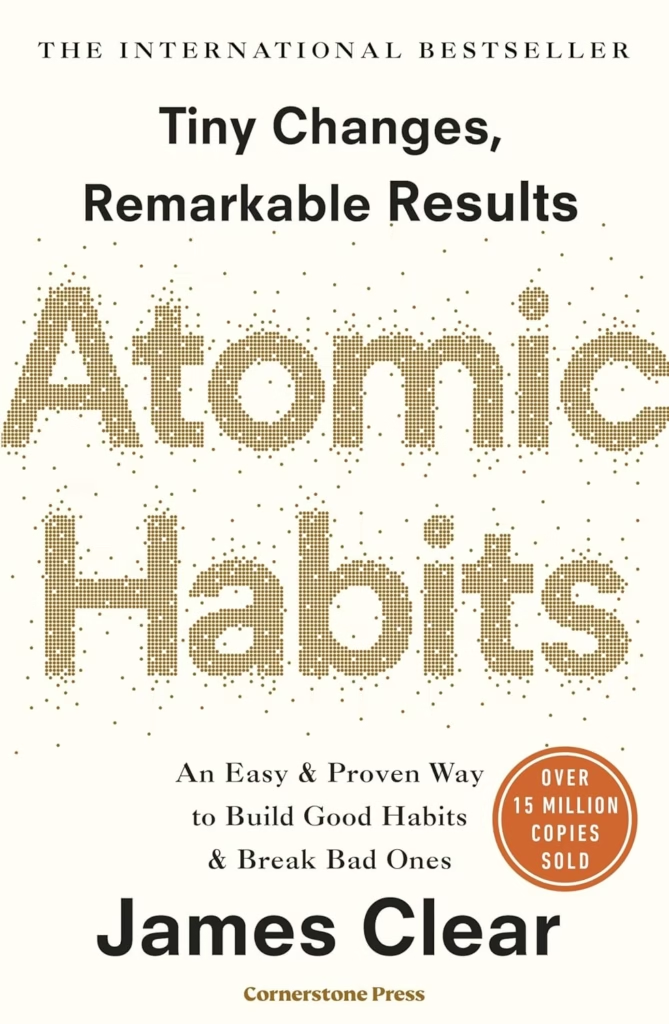Your cart is currently empty!
Top 10 Transformative Lessons from Atomic Habits to Change Your Life

Introduction – Atomic Habits
James Clear’s Atomic Habits is more than a self-help book—it’s a science-backed manual on how tiny, consistent changes can lead to extraordinary personal and professional growth. In over 2000 words, we’ll unpack the key takeaways, frameworks, and actionable insights from the book to help you understand:
- Why habits matter
- How they are formed
- How to build good habits and break bad ones
- How to make habits stick for a lifetime
Let’s explore how small changes can make a big difference.
Table of Contents

The Core Idea: Atomic = Tiny + Powerful
Clear defines “atomic habits” as small routines or behaviors that are incredibly powerful over time. Rather than focusing on massive changes, Clear emphasizes the value of marginal improvements—improving just 1% every day can compound into remarkable results.
Key Insight: Small habits, when repeated consistently, have a compounding effect that can change your identity and outcomes.
Why Habits Matter More Than Goals
Clear makes a strong case that systems (your daily habits) matter more than goals. While goals give direction, systems are what actually produce results.
- Goals are about the results you want to achieve
- Systems are about the processes that lead to those results
Quote: “You do not rise to the level of your goals. You fall to the level of your systems.”
Takeaway: Focus on creating systems that make success inevitable.
The Four Laws of Behavior Change
Clear structures the book around a four-step model for habit formation, and provides a corresponding law for building and breaking habits:
1. Cue (Make it Obvious)
- The trigger that initiates the behavior
- Make cues visible and aligned with your desired habit
2. Craving (Make it Attractive)
- The desire or motivation behind the habit
- Bundle temptations with positive routines (temptation bundling)
3. Response (Make it Easy)
- The actual behavior
- Reduce friction by designing your environment for success
4. Reward (Make it Satisfying)
- The outcome that reinforces the behavior
- Use immediate rewards to make habits feel satisfying
Habit Loop Formula: Cue → Craving → Response → Reward
Takeaway: To build a habit, follow these four laws; to break a habit, invert them.
The Role of Identity in Habits
One of the most transformative insights is that behavior change is an identity change.
- Don’t focus on what you want to achieve, focus on who you wish to become
- Every action is a vote for the type of person you want to be
Example: Instead of “I want to run a marathon,” shift to “I am a runner.”
Key Insight: Your habits shape your identity, and your identity reinforces your habits.
Habit Stacking and Implementation Intentions
Habit Stacking:
- Tie a new habit to an existing one
- Formula: “After [current habit], I will [new habit]”
Example: After I brush my teeth, I will meditate for 1 minute.
Implementation Intentions:
- Plan exactly when and where you will perform the habit
- Formula: “I will [behavior] at [time] in [location]”
Why it works: It eliminates ambiguity and decision fatigue
Make Good Habits Easy, Bad Habits Hard
Clear emphasizes environment design:
- Make the desired action frictionless
- Remove obstacles
- Add cues for good habits
Example: If you want to read more, leave a book on your pillow.
To break bad habits:
- Increase friction
- Make them inconvenient
- Create barriers
Example: Delete social media apps from your phone
The Plateau of Latent Potential
Progress is often invisible at first. Clear explains that habits compound—just like money.
- You might not see immediate results
- Habits need time to break through the “valley of disappointment”
Quote: “Complaining about not achieving success despite working hard is like complaining about an ice cube not melting when you heated it from 25 to 31 degrees.”
Takeaway: Be patient. Results will come.
Tracking and Accountability
Tracking habits creates motivation:
- Use habit trackers, journals, or apps
- Don’t break the chain—aim for consistency
- Missing once is okay, twice is the start of a new habit
Accountability amplifies success:
- Use an accountability partner
- Join groups with the same habits you want to build
- Create contracts for consequences
Key Insight: What gets measured, gets managed.
Inversion of the Laws: Breaking Bad Habits
To break a bad habit, reverse the four laws:
- Make it Invisible: Remove cues
- Make it Unattractive: Reframe your mindset
- Make it Difficult: Add friction
- Make it Unsatisfying: Create negative consequences
Example: Want to stop snacking? Don’t keep snacks in the house (invisible + difficult).
Advanced Tactics: Mastery and Sustainability
Clear explores how to keep habits sustainable long-term:
- Focus on repetition, not perfection
- Design systems that scale with your life
- Anticipate setbacks and have a recovery plan
The Goldilocks Rule:
- Work on habits that are not too easy, not too hard
- Keep habits in the zone of optimal challenge
Tip: Reframe boredom and plateaus as part of mastery
Habits in Different Areas of Life
Clear offers examples of how habits apply across life domains:
Health
- Exercise daily using identity-based goals
- Eat better by preparing your environment (e.g., meal prep)
Productivity
- Set clear intentions
- Create rituals to start deep work
Relationships
- Show appreciation daily
- Remove distractions during quality time
Finances
- Automate savings
- Review spending weekly
Takeaway: The same laws apply, no matter the domain
Common Pitfalls and How to Avoid Them
- All-or-nothing thinking – consistency beats perfection
- Overambitious goals – focus on sustainable change
- Lack of clarity – plan when/where/how
Solution: Use small steps, specific triggers, and patience
Conclusion: The Compound Power of Small Wins
Atomic Habits delivers a powerful message: you don’t need radical change to achieve extraordinary results. What you need is:
- Clear systems
- Consistent repetition
- Identity alignment
- Long-term thinking
James Clear provides a masterclass in how to take control of your habits and, by extension, your life. Whether your goal is to be healthier, wealthier, or simply more focused, start small, stay consistent, and trust the process.
The best version of yourself is just a habit away—and remember, the Take is Yours.
Buy full copy here!!

- Unleashing the Future: Top 10 Healthcare AI Tools Revolutionizing Patient Care in 2025
- Ultimate Guide to Sustainable Travel Tips and Eco Friendly Travel 2025: Embrace Conscious Travel Trends & Green Travel Destinations
- Ultimate AI Revolution Uncovered: How Artificial Intelligence is Impacting Daily Life Globally in 2025
- Ultimate Digital Nomad Destinations 2025: Discover Where the World’s Best Remote Workers Are Heading Next
- The Future of Remote Work 2025 Trends Shaping How We Work

Leave a Reply
You must be logged in to post a comment.